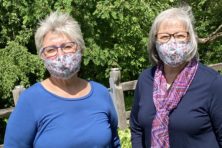Five things you might not know about Irish contributions to Door County
- Share
- Tweet
- Pin
- Share

Door County may be better-known for Scandinavian or Belgian heritage, but it has even slightly more cause to celebrate St. Patrick’s Day than the country at large – 10% of the Door County population identify with Irish heritage, compared with 9.5% across the U.S., according to the 2020 U.S. Census data.
While some 19th century immigrants arrived in groups to establish colonies, the Irish escaping English oppression, poverty and potato-crop failures often came as single families, individuals or brothers and cousins, according to Farewell to the Homeland: Immigration to Northeast Wisconsin.
That history noted that the Irish were greeted by discrimination and moved on from eastern states such as New Hampshire, which required them to swear an oath against the Pope and banned them from owning land until 1856.
But, did you know?
Washington Island had an Irish settlement. The 1860 U.S. Census identified more than 40 Irish-born men residing on Washington Island, which, according to town archivist Steve Reiss, had a population of 650 at the time.

A majority were ages 25-45 and lived in cabins in “The Irish Village” near the deep-water dock along the west edge of Washington Harbor and north of Schoolhouse Beach, Reiss said.
“That harbor was the only one where sailing ships could come in,” Reiss said. “The main livelihood of everybody up here at that time was fishing.”
The island population dropped by more than 50% near the end of the Civil War, as men went to war and life on the island became even tougher, he said.
Baileys Harbor Benefited from an Irishman’s Generosity
In the mid-19th century, many of Baileys Harbor’s Irish families resided near Kangaroo Lake and the McArdle families had farmland near there.
The fifth of eight siblings, Michael McArdle attended the teachers college at Jacksonport, taught school, studied law, published five arithmetic books, landed a government position during the development of the Panama Canal and became president of the parent company of Sunbeam Corp., according to the historical society.
He put Baileys Harbor residents to work during the Great Depression building Maxwelton Braes lodge and golf course. His generosity also enabled the construction of the St. Mary of the Lake Catholic Church, McArdle Cancer Research Laboratory at Madison and Baileys Harbor Town Hall and McArdle Library.
“The house that he and Grandpa lived in is where the cart garage for Maxwelton Braes is,” said Mike Rakowiecki, grandson of Michael’s brother, James McArdle, a longtime farmer.
Yes, O’Meara’s Irish House is Irish
When Megan O’Meara founded her business near Gibraltar Area School in 1999, it had operated since 1973 as Murray’s Irish House. She vacationed here for years with family and jumped at the chance to buy the store when she discovered it was for sale.

Her dad, retired McHenry, Illinois police chief Tom O’Meara, helps at the store. He grew up in the no-longer-Irish, west-Chicago Austin neighborhood, the son of policeman Martin O’Meara.
A photo in the shop of Martin in uniform serves as a conversation starter. Police officers and firefighters from throughout the Midwest have given Tom uniform patches, which he displays on beams throughout the store.
Megan said Irish girls who’ve worked for her in summers have said Door County reminds them of Ireland, due to small shops and stone fences around fields.
The Carmody Family’s Impact Countywide
Egg Harbor researcher Giz Herbst said the Carmody family had a major presence not only south of Sturgeon Bay near present-day Robert M. Carmody County Park but also in Egg Harbor Township.

Land near Sunny Point Road was at one time called Carmody Prairie. William and Margaret Carmody donated land in 1876 for St. John of the Desert Catholic Church at the present-day St. John the Baptist Cemetery. In 1888, a slightly larger church went up just to the north in the location where the Sawyer family erected the Landmark sign along state Highway 42 in the 1980s.
Early Leader Landed at Forestville by Accident
James Keogh, formerly of Dublin, with his wife and children and three Irish men from the Perry family, disembarked, went for a stroll, missed their boat and got recruited by a talkative War of 1812 veteran, Maj. James McCormick, to work and settle in Forestville, according to Hjalmar Holand’s Door County history stories.
Keogh became a banker, mayor of Sturgeon Bay, president of a land company and W.O. Brown Manufacturing, officer of the Sturgeon Bay Dock Co. and Ahnapee and Western Railroad, and a one-term member of the Wisconsin General Assembly (1891-93).


